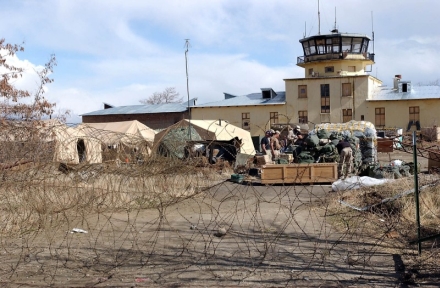Canada is increasing its troop levels in Afghanistan to 2,300 next month. And Canada will soon be taking over command of the multinational forces there. Canada will soon be leading the war in Afghanistan.
If that surprises you, you’re not alone. I don’t think many Canadians realize what’s going on there, in large part because our government does not seem to want to talk about it. In fact, although a recent nationwide poll indicated that 62% of Canadians are opposed to sending troops to Afghanistan, and 73% say there should be a vote in Parliament before doing so, the Conservatives have rejected holding such a vote.
There are many unanswered questions about Canada’s participation, and forthcoming leadership, of the war in Afghanistan. The destination of people captured by Canada’s troops is one of them. Where do Canada’s prisoners go?
I looked around on the net to find answers and found little. We do know that Canada has handed over prisoners to the US in the past, and I have not found anything to suggest this practice has stopped. These people most likely end up in Bagram.

Bagram
The detention facility at Bagram, which is an American air base about 80 kilometres north of Kabul, used to be a machine shop. Bagram was the subject of a recent New York Times piece entitled A Growing Afghan Prison Rivals Bleak Guantánamo:
While an international debate rages over the future of the American detention center at Guantánamo Bay, Cuba, the military has quietly expanded another, less-visible prison in Afghanistan, where it now holds some 500 terror suspects in more primitive conditions, indefinitely and without charges.
But some of the detainees have already been held at Bagram for as long as two or three years. And unlike those at Guantánamo, they have no access to lawyers, no right to hear the allegations against them and only rudimentary reviews of their status as “enemy combatants,” military officials said.
Conditions at Bagram are harsher than Guantanomo. And it operates in total secrecy:
While Guantánamo offers carefully scripted tours for members of Congress and journalists, Bagram has operated in rigorous secrecy since it opened in 2002. It bars outside visitors except for the International Red Cross and refuses to make public the names of those held there. The prison may not be photographed, even from a distance.
From the accounts of former detainees, military officials and soldiers who served there, a picture emerges of a place that is in many ways rougher and more bleak than its counterpart in Cuba. Men are held by the dozen in large wire cages, the detainees and military sources said, sleeping on the floor on foam mats and, until about a year ago, often using plastic buckets for latrines. Before recent renovations, they rarely saw daylight except for brief visits to a small exercise yard.
Any prison that is “far worse” than Guantanomo, in the words of a US Defence Department official, ought to be cause for significant concern, especially after this report from the depths of Guantanomo by a lawyer for prisoners there, entitled American Gulag:
What I have witnessed is a cruel and eerie netherworld of concrete and barbed wire that has become a daily nightmare for the nearly 500 people swept up after 9/11 who have been imprisoned without charges or trial for more than four years. It is truly our American gulag.
The article is mostly about the conditions within Guantanomo and his client’s hunger strike there, but he also writes about the treatment that people endured after being captured:
Every prisoner I’ve interviewed claims to have been badly beaten and subjected to treatment that only could be called torture, by Americans, from the first day of U.S. captivity in Pakistan and Afghanistan. They said they were hung by their wrists and beaten, hung by their ankles and beaten, stripped naked and paraded before female guards, and given electric shocks
Is this what happens to the people Canada hands over to American forces in Afghanistan?
If Canada’s prisoners don’t end up in Bagram, then perhaps they end up in Pul-i-Charkhi, Kabul’s biggest prison, which is currently in the throes of a massive riot.
Police and troops ringed Kabul’s main jail on Monday after hundreds of inmates led by Taliban commanders and a kidnap gang leader took over cell blocks, including one housing women and children.
More than 1,000 prisoners took over parts of the Pul-i-Charkhi prison on Kabul’s eastern outskirts late on Saturday and inmates said that four of their number had been killed and 38 wounded since.
You read that right: women and children. Bizarrely, women prisoners keep their children with them in the jail.
[Nader] Nadery [from the Afghan Independent Human Rights Commission], said Taliban suspects, about 200 of whom were being held without trial, were demanding to be tried or freed, and prisoners were also demanding an end to a new rule requiring them to wear uniforms and the removal of cell bars.
“Demanding to be tried or freed”. What a remarkably Western demand. But in America’s war on terror, the people who actually get charged with crimes are the lucky ones.
The Globe and Mail today is featuring a special report today called Should Canada lead the fight in Afghanistan? It features statements from the four major national parties on the issue, and gives readers the opportunity to pose questions to the parties.
I asked the question I’m asking here, so with a bit of luck, maybe we’ll get some answers.

 twitter.com/adriandz
twitter.com/adriandz
